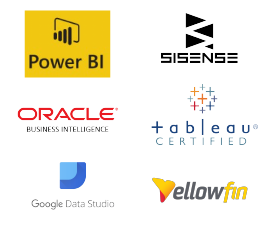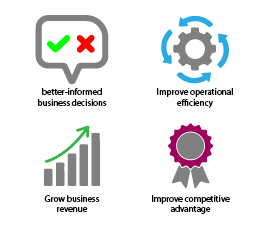Business Intelligence (BI)
As we have already discussed big data and its importance, the next necessity of a business is to find a method or strategy that studies this data and discovers actionable insights for business growth. That’s where Business Intelligence (BI) comes into the spotlight. According to the present business landscape, achieving business intelligence is a must. But surveys show reveal that most of the enterprises are yet to realize its importance and the benefits.
Statistics
According to a Reuters report, the Global Business Intelligence market is expected to grow from $15.64 billion in 2016 to $29.48 billion by 2022, with a CAGR OF 11.1%. Though the growth is predicted to be steady, the market absorption of data analytics, cloud technologies and the growing relevance of data are expected to trigger the momentum. More and more small and medium-sized business enterprises are expected to leverage data intelligence.
Business Intelligence Tools
If survey findings are to be believed, then the BI and analytics software market are estimated to be worth more than $20 billion by the year 2020. Business Intelligence tools will gain prominence in the immediate future. There are several tools that will help to interpret data for deriving better-informed decisions regarding business strategy. These tools are cost-effective and some of them are even easy to use. Let’s evaluate some of the commonly used tools.
- Microsoft Power BI
Launched in 2015, Microsoft Power BI is one of the affordable options which is ideal for small and medium-sized businesses who rely on smaller data sets. The web-based business analytics tool separates itself for data visualization capabilities and real-time trend analytics. Moreover, the functionality is similar to Microsoft Excel, which makes it easy for professionals to handle. It can also be seamlessly integrated with SQL as well.
- Sisense
Are you relatively new to technology? Then Sisense easily qualifies to become your first choice. It is highly user-friendly with simple dashboards. Unlike Microsoft Power, Sisense helps an organization to effectively manage large and complex data sets at ease, thanks to its columnar approach and powerful CPU speed. With more results, Sisense becomes ideal for big enterprises, but it is one of the costliest business tools available in the market.
- Oracle BI
As the brand name indicates, it is definitely one of the big fishes in terms of business intelligence. The tool seamlessly empowers business by discovering actionable insights through its powerful and visually stunning analytics. Being a hybrid platform, Oracle delivers a comprehensive view of business data in one place. The platform relies on dashboards, proactive intelligence, ad hoc and much more which makes it a robust solution for business.
- Tableau
This is perhaps one of the most powerful, secure and flexible end to end BI platform for enterprises. The prime USP’s can be attributed as data discovery and data visualization. The interactive dashboard is easy to analyze, visualize and share data without any interventions. The platform supports multiple data sources like MS Excel, SQL, Google Analytics, etc. They also have multiple customized versions for suiting the precise needs of every business.
- Google Data Studio
An easy and free to use tool for businesses. Since it is incepted to the pioneers Google, this platform can be easily integrated with various other Google platforms. Quick enactment of data and its integration options seems to make you think that its ideal. If you are a seed stage enterprise, then you can justify the thought, but Google Data Studio is not an advanced version of BI tools as it lacks sophisticated visualization tools.
- Yellowfin BI
Yellowfin combines facets like visualization, machine learning and scores high for its collaboration capabilities. Using intuitive filtering, like radio buttons and checkboxes, the platform can easily filter massive parcels of data. The detailed and open dashboards help data filtering remarkably easier. Yellowfin is definitely one of the flexible business intelligence tools in terms of accessibility.
Business Intelligence Trends
As per Forbes data, the market absorption of business intelligence relied on three different verticals namely, Executive Management, Operations, and Sales. The list was followed by Finance, Marketing, and Information Technology. In order to deliver prompt service, BI tools mostly relied on better dashboards, reporting tools, advanced data visualization, and data warehousing techniques.
In an interesting finding, small organizations under 100 employees were in the forefront to adopt business intelligence tools. This trend is quite evidently pinpointing that the trend is here to stay. The main reasons for enterprises to rely on intelligence are to;
- Enable them to gain better insights on data that helps in making better-informed business decisions,
- Improve the operational efficiencies like inventory management, accounting, customer service and much more.
- Growing business revenue through successfully conducting marketing analysis, customer segmentation, channel management, CRM, etc.
- Improving competitive advantage by filtering, analyzing and deriving intelligent and meaningful business information.
The Testimonials
The concepts of modern-day intelligence platforms are not only a theoretical event to follow. In the so far roadmap, there are several instances where business churned out greater advantage from BI. Coca Cola leveraged intelligence to automate their manual reporting process, which saved them enough manual resource time. Their sales team engaged in the field with mobile dashboards that provided timely insights on conducting CRM process.
The famous American restaurant chain Chipotle was concerned over disparate data sources that created a barrier for viewing a unified listing of restaurants. They had business data arriving from over 2400 locations across the world. By replacing their ordinary BI tool with a sophisticated one, Chipotle centralized their national scale operations and streamlined their report delivery (monthly, quarterly) in an efficient manner.
Des Moines Independent Community School District, the largest of its kind in Lowa, followed manual reporting of data like attendance that prevented the timely intervention of officials. By relying on advanced analytics solutions, Des Moines managed not only to streamline the administration process but also succeeded in understanding the importance of methods of education on every student.
HelloFresh SE, an international meal kit company located in Berlin, Germany, managed to save 10-20 valuable hours of work for their dedicated analytics team, thanks to the centralized business intelligence tool. By automating the business vertical, the company empowered their analytics team to curate and run regional personalized campaigns. They closely examined customer behaviour and created accurate buyer personas that resulted in better conversions.
The old vs the new
A few years before, securing business data was hindered by technical limitations based on storage and computing. Today BI tools have the significant advantage of having mobile and cloud compatibility, which has empowered users to access data from anywhere. Gone are the days of conditioned users and seasoned answers for marketing queries. Now you can answer any of the customer’s queries with access to data.
Today, we are passing through an exciting period of data. More and more companies are succeeding their business strategies through business intelligence. Sophisticated tools enable enterprises to creatively view and use data to answer a wider range of customer problems. The classic comparison of Netflix and Disney underlines the scope of business intelligence.
Disney delivered compelling stories to the masses. They possess a huge library of creative content. Being an undisputed entertainment leader, Disney enjoyed the realm for decades. As business intelligence gained momentum, it was data companies like Netflix, which primarily assumes as an entertainment company notched to success by delivering entertainment experiences in a personalized way to fit the preferences of the audience.
Summing up, becoming a data-driven enterprise is a drastic cultural shift. They need to ask more questions, reach out to customers and dig up the data to find the truth behind every brand. They need to remove the biased elements of business through data interpretations to reveal the most accurate answers for their business. The solutions you are searching is around the corners of the world. New age big data is all about making a commitment to what you do!




